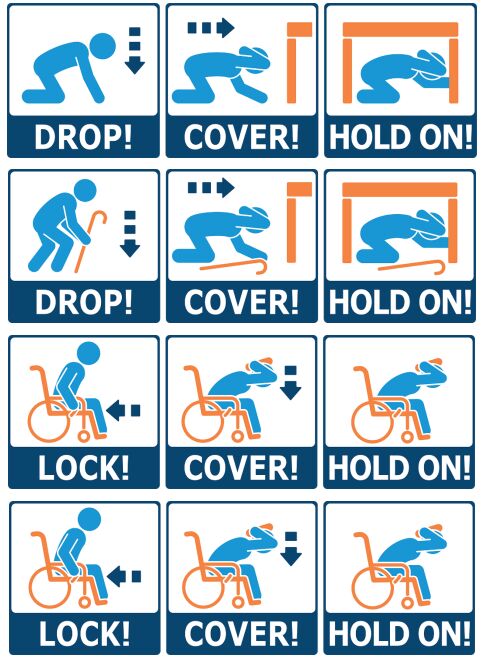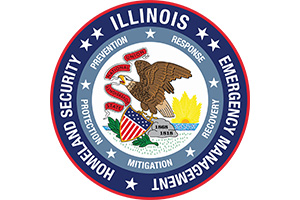- Details
Severe Weather in Midwest Can Be Spawned by Hurricanes
IEMA-OHS encourages residents to be prepared for the effects of strong hurricanes
- Details
April is Hazardous Materials Safety Month
- Follow the instructions on the label for use and storage.
- Don't mix products. This can cause deadly gases or a fire.
- Store products in their original containers.
- Store anything that can catch on fire away from your home.
- Only fill portable gasoline containers outdoors. Make sure to place the container on the ground before you fill it.
- Never store materials that can cause a fire in the sun or near an open flame or heat source.
- Store hazardous materials out of the reach of children and pets.
- Use safety locks and guardrails on shelves and cabinets when you store materials. This will prevent them from falling or tipping.
- Wear gloves or goggles when you use these materials.
- Details

IEMA-OHS Commemorates 100th Anniversary of the Deadliest Tornado in Illinois
March is Severe Weather Preparedness Month
Springfield – On March 18, 1925, the deadliest tornado in U.S. history tore through southeast Missouri, southern Illinois, and southwest Indiana, leaving a 219-mile path of destruction.
“During this Severe Weather Preparedness Month, I want everyone in Illinois to recognize the dangers of tornadoes and other weather disasters,” said Illinois Emergency Management Agency and Office of Homeland Security (IEMA-OHS) Director Alicia Tate-Nadeau. “That tornado, 100 years ago this month, killed 234 residents in Murphysboro alone, making it the hardest-hit town in Illinois during that storm. A total of 695 people lost their lives across the tri-state area. We want Illinoisans to take preparedness seriously—know the risks, have a plan, and review your insurance coverage.”
National Weather Service Lincoln Warning Coordination Meteorologist Ed Shimon emphasized the importance of preparedness. “Devastating tornadoes have occurred in every month of the year. We encourage everyone to have a tornado safety plan and practice it regularly. When a tornado is approaching, seconds can save lives.”
Flooding: Another Major Threat in Illinois
In addition to tornadoes, flooding remains one of Illinois’ most significant weather threats. In 2024, Illinois experienced a major presidential disaster declaration for severe weather and flooding, resulting in over $150 million in damages.
Nationally, flooding is the most common natural hazard, yet many homeowners remain uninsured against flood damage. The Illinois Department of Insurance (IDOI) and the Illinois Department of Natural Resources (IDNR) recommend that homeowners, renters, and businesses consider flood insurance to protect their property and belongings.
“Flood insurance must be purchased separately from most homeowners and renters policies and typically takes effect 30 days after purchase,” said IDOI Acting Director Ann Gillespie. “If your community is not eligible for the National Flood Insurance Program (NFIP), private flood insurance may be available from a licensed agent or insurer. Our IDOI insurance analysts can help answer questions about coverage options.”
Flood insurance is available through the National Flood Insurance Program (NFIP) for residents of nearly 23,000 participating communities nationwide. A list of participating flood insurance providers can be found here.
Consider Earthquake Insurance
Illinois residents should also review their earthquake insurance options. Standard homeowners insurance policies may not cover earthquake damage, and coverage varies by provider. When evaluating earthquake insurance, consider whether your policy includes all structures (home, garage), contents, and any exclusions or limitations.
Be Prepared: Steps to Protect Your Home and Family
IEMA-OHS recommends that you:
• Keep all important records and documents in a secure waterproof container
• Make an inventory of possessions using lists and photos/videos
• Insure your property and personal items
• Know how to shut off your home utilities like electricity, gas, and water
• Assemble an emergency kit and “go bag” to help your family for at least three days during extended power outages or in case of evacuation
• In case power is out, make sure flashlights with fresh batteries are ready
• Generators should only be run outside, never indoors or in enclosed spaces
More tips and preparedness kit ideas can be found at
https://ready.illinois.gov/plan/emergencykit.html
Details of the 1925 tornado can be found in a report by the Illinois State Water Survey, Urbana-Champaign:
https://climateillinois.wordpress.com/wp-content/uploads/2015/03/reduced-iswsc-103.pdf
Illinois Emergency Management Agency and Office of Homeland Security (IEMA-OHS): Ready.Illinois.Gov
IEMA-OHS Social Media: X/Twitter | Meta/Facebook | Instagram | LinkedIn | YouTube
###
- Details

Practice Drop, Cover, and Hold On!
During Earthquake Awareness Month
SPRINGFIELD –The Illinois Emergency Management Agency and Office of Homeland Security (IEMA-OHS) is encouraging everyone in Illinois to practice how to Drop, Cover, and Hold On! during Earthquake Awareness Month.
“A strong earthquake won’t just affect southern Illinois, but the entire state given its proximity to two major seismic zones—the New Madrid Seismic Zone on the border with Missouri and the Wabash Valley Seismic Zone on the border with Indiana,” said Director Alicia Tate Nadeau. “The best way to stay safe during an earthquake is to Drop, Cover, and Hold On! If you practice this regularly, you’ll know exactly what to do during an earthquake because a strong earthquake could easily affect homes and infrastructure throughout Illinois.”
Whether you are in your home, a school classroom, a high-rise or other type of building, it is important to know how to protect yourself during an earthquake. Practice what to do during an earthquake with your family members so you can react automatically when the shaking starts.
If you are indoors, follow these steps to Drop, Cover, and Hold On:
• Drop down to the floor
• Take Cover under a sturdy desk, table, or other furniture
• Hold on to that object until the shaking ends
Details on how persons with disabilities can adapt Drop, Cover, and Hold On! to reduce injury or death during an earthquake, can be found here.
Another option for earthquake preparedness is to join the national ShakeOut drill in October where nearly 20 million people across the U.S. practice their earthquake response.
IEMA-OHS also offers disaster preparedness information on the Ready Illinois website, a one-stop resource for detailed information about what to do before, during and after disasters. For more information on earthquake preparedness, visit
https://iemaohs.illinois.gov/preparedness/earthquake.html.

Illinois Emergency Management Agency and Office of Homeland Security (IEMA-OHS): Ready.Illinois.Gov
IEMA-OHS Social Media: X/Twitter | Meta/Facebook | Instagram | LinkedIn | YouTube
###
- Details

IEMA-OHS Encourages Testing During Radon Action Month
Press Release - Friday, January 10, 2025
IEMA-OHS and the American Lung Association relaunch two statewide awareness contests
SPRINGFIELD - With no scent, color, or taste, radon is a stealthy killer. In fact, it's the second leading cause of lung cancer in the U.S. "January is National Radon Action Month and a good opportunity to learn about this gas," explained Illinois Emergency Management Agency and Office of Homeland Security (IEMA-OHS) Director Alicia Tate-Nadeau.
"It is estimated that more than 1,100 people in Illinois develop radon-related lung cancer each year. IEMA-OHS is encouraging all property owners and renters to understand the risk and test for radon," said Tate-Nadeau.
Radon test kits can be purchased by calling the Illinois Radon Hotline at 800-325-1245 or at most hardware and department stores. It is recommended to conduct one short-term test and one long-term test to ensure consistent readings. Should you find higher readings, you should contact IEMA-OHS at 800-325-1245 for information about a licensed mitigation professional who are trained to reduce radon levels.
For information on radon measurement, mitigation, and licensing, visit the IEMA-OHS Radon page at https://iemaohs.illinois.gov/nrs/radon.html. Information is also available through IEMA-OHS' Radon Hotline at 800-325-1245.
Statewide Awareness Poster & Video Contests
IEMA-OHS and the American Lung Association (ALAIL) will also hold two statewide contests that encourage school students to create awareness posters or videos to increase knowledge among their classmates. High school students can enter a 30-second commercial style video, while middle school students can enter a poster that encourages radon testing.
"Radon is responsible for an estimated 21,000 lung cancer deaths every year and is the leading cause of lung cancer in people who have never smoked. Since radon is odorless, tasteless and colorless, the only way to detect radon in your home is to test the air. This is why it is critical for everyone to test their home," said Jill Heins-Nesvold, Nationwide Senior Director of Indoor Air Quality for the American Lung Association. "This contest is a perfect way for everyone to learn more about this dangerous gas and take action to protect yourself and your loved ones."
|
|
||
|
Eligibility |
Students Age 9-14 |
All High School Students |
|
Registration Status |
Now Open |
Now Open |
|
Submissions Due |
March 10 |
March 10 |
|
First Prize |
$200 |
$600 |
|
Second Prize |
$150 |
$500 |
|
Third Prize |
$100 |
$400 |
|
Most Views Winner |
n/a |
$200 |
Both contests are sponsored by IEMA-OHS and the American Lung Association. For more information on the awareness poster and video content, visit https://iemaohs.illinois.gov/nrs/radon/radoncontest.html.
2024 Radon Poster Winners
- 1st place - Hufford Junior High School (Gabriela S.)
- 2nd place - Reservoir Gifted Academy (Lilly D.)
- 3rd place - St. Alphonus/St. Patrick School (Amelia D.)
2024 Radon Video Winners
- 1st place - Morris Community High School (Callie F., Janelle D., and Elise K.) https://www.youtube.com/watch?v=u2t2PaWEd3c
- 2nd place - Morris Community High School (Olyvia P.) https://youtu.be/LtPTMrhlO5g?si=-eG6EqhSVZHIMrcW
- 3rd place - Mahomet-Seymour High School (Brianna D. and Braden P.) https://www.youtube.com/watch?v=K_rb1CU5KME
Illinois Emergency Management Agency and Office of Homeland Security (IEMA-OHS): Ready.Illinois.Gov
IEMA-OHS Social Media: X/Twitter | Meta/Facebook | Instagram | LinkedIn | YouTube
Page 2 of 44





